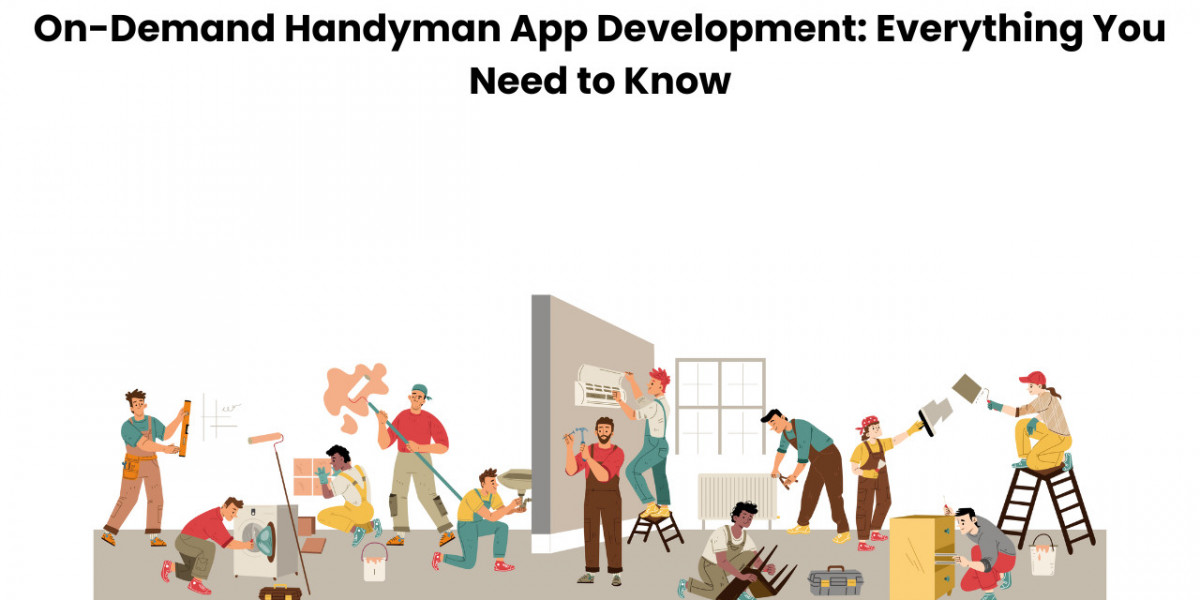In today’s fast-paced world, convenience is everything. People want services at their fingertips, and this is particularly true for tasks around the house that require professional help. An on-demand handyman app allows users to book services like plumbing, electrical work, furniture assembly, or even home repairs with just a few taps on their smartphones. If you're thinking about developing your own on-demand handyman app, this guide will take you through everything you need to know—from understanding the concept and key features to the development process.
1. Understanding the Concept of an On-Demand Handyman App
On-demand handyman apps are mobile platforms that connect customers with skilled professionals who can help them with a wide range of home repair tasks. These apps allow users to request services instantly, find a nearby handyman, and book appointments—all from the comfort of their homes.
Why On-Demand Services are Popular
The on-demand economy is booming. Consumers prefer services that save time, offer convenience, and provide quick solutions to their needs. On-demand handyman apps are appealing because they eliminate the hassle of searching for a trusted professional, getting quotes, and scheduling appointments through traditional methods. Instead, users can quickly browse available services, check ratings, and book a handyman whenever they need one.
2. Key Features to Include in an On-Demand Handyman App
To build a successful on-demand handyman app, it’s important to integrate essential features that make the app functional, reliable, and easy to use. These features not only enhance the user experience but also ensure smooth operations for both the customer and the service provider.
1. User-Friendly Registration and Login
The first step in creating a seamless experience is making the registration process simple. Allow users to sign up using their social media accounts (Facebook, Google) to speed up the process. Keep the forms short and simple to avoid friction at this stage.
2. Service Catalog
An organized service catalog is a must. Users should be able to browse different types of handyman services, like plumbing, electrical repairs, carpentry, and more. Group services into clear categories and provide detailed descriptions so users know exactly what to expect.
3. Real-Time Availability and Booking
One of the most important features of any on-demand app is real-time availability. Users should be able to see when handyman are available and book a service instantly. Allow them to choose a time slot that fits their schedule. This feature helps to streamline the booking process and gives users the flexibility to choose.
4. GPS Tracking
Location tracking is vital for on-demand services. The app should allow users to see nearby handyman and track their arrival in real-time. For handyman, GPS helps with accurate navigation to reach customers quickly and efficiently. It also builds trust, as users can track when their handyman will arrive.
5. Payment Integration
A secure and easy-to-use payment system is essential. Users should have the option to pay through various methods like credit cards, debit cards, PayPal, or even mobile wallets. Offering multiple payment options increases the convenience and reduces the chances of abandoned bookings.
6. Rating and Review System
After the service is completed, users should be able to rate the handyman and leave reviews. This helps maintain quality standards, allows other users to make informed decisions, and gives handyman valuable feedback to improve their skills.
7. Communication Tools
An in-app messaging or calling feature allows users to communicate with their assigned handyman before and during the service. This ensures that the user and handyman are on the same page about the task at hand, which can prevent misunderstandings and errors.
8. Notifications and Reminders
Push notifications are an effective way to keep users engaged and informed. Notifications can alert users about service updates, booking confirmations, reminders for upcoming appointments, or new promotions. They can also notify users when the handyman is on the way or when the job is complete.
9. Admin Dashboard
For app administrators, a robust admin dashboard is necessary. It should offer features like managing user accounts, overseeing bookings, processing payments, and monitoring ratings and feedback. The dashboard helps ensure that the app operates smoothly by giving admins control over the platform.
3. How to Develop an On-Demand Handyman App
Now that we’ve covered the essential features, let's dive into the app development process. Building an on-demand handyman app involves several stages, from planning and design to development and launch. Here’s an overview of the key steps in the process.
1. Research and Planning
Before beginning development, research your target audience, competitors, and industry trends. Understand what your target users want, what problems they face, and how your app can offer a solution. Look at other popular handyman apps to identify gaps in the market and features that users like. Create a detailed business plan that outlines your app’s features, functionalities, and revenue model.
2. Design the User Interface (UI)
A clean and intuitive design is essential for the success of your app. Focus on designing an easy-to-navigate interface that’s visually appealing and functional. Your app’s UI should ensure that users can quickly find the services they need and book them with minimal effort. Work with a designer to create wireframes and prototypes before moving on to actual development.
3. Choose the Development Approach
When it comes to building your app, you can either opt for a native app (specific to iOS or Android) or a hybrid app (works across both platforms). Native apps tend to offer better performance but are more expensive to develop. Hybrid apps are a cost-effective option but may lack the performance of native apps. Choose the approach based on your budget, timeline, and target audience.
4. Develop the Front-End and Back-End
The front-end of the app is what users interact with, so it needs to be responsive, visually appealing, and functional. The back-end, on the other hand, powers the app’s features, including the database, user management system, and payment processing.
For the front-end, you can use technologies like React Native, Swift, or Kotlin for iOS and Android development. For the back-end, use frameworks like Node.js, Ruby on Rails, or Django to handle user authentication, service booking, payments, and other essential functions.
5. Testing and Quality Assurance
Testing is crucial to ensure your app works flawlessly. Run beta testing with a select group of users to identify bugs, glitches, or usability issues. Focus on testing features such as the booking system, GPS tracking, payment integration, and communication tools. Once testing is complete, fix any issues and ensure the app runs smoothly on both iOS and Android devices.
6. Launch and Marketing
Once the app is developed and tested, it’s time for launch. Submit your app to the App Store (for iOS) and Google Play Store (for Android). After launch, promote your app through social media, SEO, and paid advertising. Consider offering discounts or free trials to attract new users. Encourage users to leave reviews and ratings to boost your app’s visibility.
Read more: 10 Key Benefits of Using a Handyman App Like Uber for Your Home Service Business
4. Monetization Strategies for Your On-Demand Handyman App
Now that your app is live, it’s time to think about how to make money. There are several monetization strategies you can use for your on-demand handyman app:
1. Commission-Based Model
Charge a commission on every job completed through the app. You can set a fixed percentage that you take from the total amount paid by the customer.
2. Subscription Model
Offer a subscription plan where users pay a monthly or yearly fee to access premium services, like priority bookings or discounts.
3. Service Fee Model
Charge users a small service fee for every transaction. This fee could be a flat amount or a percentage of the total bill.
4. Advertising
If your app gains significant traffic, you can monetize it by displaying relevant ads from third-party networks. However, this should be done carefully to avoid interrupting the user experience.
Conclusion
Developing an on-demand handyman app is an excellent business opportunity in the ever-growing on-demand service industry. With the right features, user-friendly design, and smooth development process, you can create an app that caters to the needs of both customers and service providers.
If you’re looking to bring your idea to life, consider partnering with an on-demand app development company. They can help guide you through the entire process—from planning and design to development and launch—ensuring your app’s success in the competitive market. With the right tools and features, your handyman app can stand out and provide value to users.











